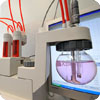M
Publication and design
Publication director: Marc Mortureux
Editor-in-chief: Paul Martin
Assistant managing editor: Barbara Gouget
Editorial board: Maria Laura Boschiroli (France, Anses), Sabine Delannoy (France, Anses), Bertrand Lombard (France, Anses), Stefano Morabito (Italy, ISS), Françoise Petter (OEPP), Elisabeth Repérant (France, Anses), Christian Tricard (France,
SCL), Thierry Van Den Berg (Belgium, Coda Cerva ), Eric Verdon (France, Anses)
Thanks to Pascale Parisot for her rereading of this issue
Creation/Development: Julien Vigneron, Céline Leterq,
Fabrice Coutureau, Parimage
Photos credits: Istituto Superiore di Sanità
ISSN 2110-5294
Editorial
Point of view
EuroReference No.7, 2012, Biotox Piratox
Lab news
Networks






Two year study of interlaboratory trial results on rabies diagnosis (Fluorescent Antibody Test, Rabies Tissue Culture Infection Test, Mouse Inoculation Test, PCR techniques): a starting point towards the harmonization of the methods
Emmanuelle Robardet (emmanuelle.robardet@anses.fr), Evelyne Picard-Meyer, Alexandre Servat, Florence Cliquet
WHO Collaborating Centre for research and management in zoonoses control, OIE Reference laboratory for rabies, European Union reference laboratory for rabies, European Union reference laboratory for rabies serology, Anses, Nancy laboratory for rabies and wildlife, Malzéville, France.
Two interlaboratory trials on rabies diagnosis techniques were organised over the period 2009-2010 by the European Union Reference Laboratory (EURL) for Rabies. Results revealed that laboratories produced the highest proportion of concordant results in PCR techniques (90.5%), FAT (87.1%), followed by RTCIT (70.0%) and MIT (35.0%) in 2009 and in FAT (85.0%) and PCR techniques (80.6%) followed by RTCIT (77.3%) in 2010. Independently of the year, the molecular techniques were the techniques presenting the lowest rate of false negative results, while RTCIT and MIT (performed in 2009 only for the latter) were the techniques with the lowest proportion of false positive results. Considering the participant laboratories results, the FAT gold standard technique presented a better specificity than RT-PCR with 1.6% false positive in 2009 and 5.8% in 2010 and a better sensibility than RTCIT with 1.6% false negative results in both 2009 and 2010. In both molecular biology techniques and FAT trial, false negative results were notified on bat strains only, highlighting the need to improve result quality more specifically on such strains. The analysis of technical questionnaires and procedures provided by participating laboratories revealed variations of methods that could cause inconsistencies between the results. In 2009, the impact of the number of readers for slide examination during the FAT was underlined as a significant factor affecting the results of laboratories, confirming the necessity of two independent readers for routine rabies diagnosis. Such findings highlight the need for all rabies diagnosis laboratories to improve harmonization of procedures. To facilitate this work, and as a first step, recommendations on the most commonly used reference techniques, FAT and RTCIT have been stated. Theses recommendations were establish based on the OIE and WHO international recommendations and on an update of the knowledge of critical factors known to affect the results.

The Focus section of this new issue of EuroReference includes a presentation of the European Union Reference Laboratory for Parasites. Based in Rome (Italy) since 2006, the EURL works on zoonotic helminths and protozoa. It carries out inter-laboratory proficiency trials, training, diagnostic activities and standardization of analytical methods on a routine basis. Here, we learn about its epidemiological work on the prevalence of four species of nematodes from the genus Trichinella circulating in Europe.
Also in this issue, two articles present some major developments in European legislation: the first, published in the Focus section, expands on the application of the new European Regulation on the protection of animals and the constraints it imposes on animal experimentation in research and reference laboratories; the second article outlines the revision of the European Regulation (EC) No 882/2004 on official controls. It will be described in further detail in the next issue of EuroReference.
The Point of View gives an example of genome sequencing, a promising method for the future of microbiology diagnostic and reference laboratories, illustrated here by its application to contagious equine metritis.
This issue, rich in diversity, also looks back over two years of inter-laboratory trials of different techniques for rabies diagnosis. It also reports on the discussion meetings of the French reference community in the fields of animal health, food safety and plant health.
A little over a year after the start of a new phase in the life of EuroReference, we are on track to achieve our objectives. Three European members (Italy, Belgium and EPPO - the European & Mediterranean Plant Protection Organization) have joined the editorial committee and will soon be joined by a fourth (Poland). We are happy to welcome them to the life and activity of the journal. Our previous two thematic issues, which were substantial and authoritative, strengthened our approach and broadened the journal's readership. The next thematic issue, in 2014, will most likely
be devoted to the surveillance networks for pathogens and contaminants in Europe.
We hope you will enjoy reading this issue of EuroReference and that it will be a valuable source of information for your professional work.
The Editorial Board
One-day event reference laboratory event: more than 100 participants
Barbara Gouget (barbara.gouget@anses.fr)
ANSES, Scientific Affairs Department for Laboratories, Maisons-Alfort, France
2013 Annual scientific meeting of MedVetNet
André Jestin (andre.jestin@anses.fr)
ANSES, Scientific Affairs Department for Laboratories, Maisons-Alfort, France
Short summary of the 2nd EPPO Workshop for heads of plant pest diagnostic laboratories
Françoise Petter (petter@eppo.int ) and Madeleine McMullen
EPPO Secretariat, Paris, France
Preparation of a European body of legislation on official controls: “Healthier animals and plants and a safer agri-food chain”
Françoise Kremer (francoise.kremer@agriculture.gouv.fr)
Department for laboratories and coordination of official control
French Directorate General for Food, Ministry of Agriculture, Food and Forestry, Paris, France
Whole genome sequencing, an efficient investment for developing diagnostic and epidemiology tools: the case of contagious equine metritis
Sandrine Petry (sandrine.petry@anses.fr)
ANSES, Dozulé Laboratory for Equine Diseases, Goustranville, France
The number of available whole genomes has been regularly increasing while costs and sequencing times continue to decrease. Many laboratories - both public and private - participate in whole genome sequencing and this investment has radically transformed basic research and all fields that deal with biological processes. In the near future, whole genome sequencing will likely become a routine tool for microbiology diagnostic and reference laboratories.
Focus on a laboratory
Agenda
- Home
- N° 12, Summer 2014
- Back issues
- N°11, Winter 2013
- N°10, Summer 2013
- N°9, Spring 2013
- No. 8, Winter 2012
- No. 7, Summer 2012
- No. 6, Winter 2011
- No. 5, Summer 2011
- No. 4, December 2010
No. 3, June 2010
- No. 2, December 2009
- No. 1, June 2009
- Search an article
- Subscribe
- Contributions



